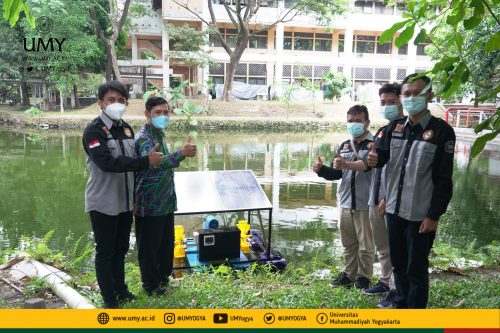UMY Vocational Machine Technology study program team creates the first IOT-based solar aerator

umy
Published on 24 October 2021

A Lecturer of the Mechanical Engineering Vocational Study Program, Universitas Muhammadiyah Yogyakarta, M. Abdus Somad ST., M.Eng., together with four students created the first IOT (Internet of Think)-based solar aerator as the operating system.
Aerators are usually used as fish pond oxygen water pumps and have been widely circulated in the market. There is also a type of aerator that is commonly used by shrimp or fish farmers in coastal areas but uses diesel power. In contrast to that,
The difference between the IOT-based solar aerator created by the UMY Vocational Machine Technology Study Program and the common Aerator is in its power and operating system. Its function remains the same, namely as an oxygen water pump and the UMY Vocational Aerator is indeed intended for shrimp and fish farmers in coastal areas. As a fulfilment of water oxygen needs for shrimp or fish, making it easier for farmers.
“Coastal areas such as the sea or the coast has limited electricity networks. Usually, the type of aerator used is diesel-powered, and the operation is still manual. We develop our tool with solar cells to save energy, in can be easily operated through the internet using the Telegram application (bot) that we developed ourselves, so it is very flexible,” said Abdus Somad, when he was testing the tool at the UMY pool, Saturday (16/10).
The process of making this IoT-based solar aerator takes three months. Starting from the idea, Abdus Somad then collaborated with his four students and made the aerator in the vocational lab located in Wirobrajan or behind the Asri Medical Center (AMC) UMY.
The tool itself consists of a black box containing a battery that functions to accommodate the power and protection of the IOT system, flanked by two yellow pinwheels on the right and left sides made of natural fibre composite material, two solar panels on the top, and two floats. of jerry cans to help the 100 kg tool float. At the time of testing, the Aerator was able to operate using Telegram bots from a distance of approximately 3 KM.
Regarding the safety of the IoT equipment itself, which is located in the black box and has the potential to be splashed by water, Abdus Somad said it is very safe. The battery in the black box has a power of 13.4 volts and can last for six hours without charging. "It's very safe, even though it's exposed to water it's still safe. It can be used from dusk until dawn because the power will be charged continuously. At night, you can use the power stored in the battery,” he continued.
This IOT-based solar aerator is also a fulfilment of the university's catur dharma, so it will be introduced to the community as a form of service. In particular, it will target shrimp or fish farmers, which is the main purpose of this tool.
“This is a form of student creativity and we will continue to guide them, especially as vocational students, not only in academic theory but also in creating a product. With this effective tool, I hope it can be useful for the community and further introduce UMY Vocational Machine Technology as a program that is able to produce useful products," said Abdus Somad. (Hbb)
